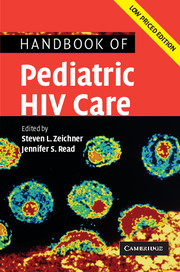Book contents
- Frontmatter
- Contents
- List of contributors
- List of abbreviations
- Foreword
- Preface
- Part I Scientific basis of pediatric HIV care
- Part II General issues in the care of pediatric HIV patients
- Part III Antiretroviral therapy
- 11 Antiretroviral therapy
- 12 Antiretroviral drug interactions
- 13 Metabolic complications of antiretroviral therapy in children
- 14 HIV drug resistance
- 15 Initiating and changing antiretroviral therapy
- 16 Therapeutic drug monitoring
- 17 HIV postexposure prophylaxis for pediatric patients
- Part IV Clinical manifestations of HIV infection in children
- Part V Infectious problems in pediatric HIV disease
- Part VI Medical, social, and legal issues
- Appendix 1 Formulary of antiretroviral agents
- Appendix 2 National Institutes of Health sponsored clinical trials for pediatric HIV disease
- Appendix 3 Selected HIV-related internet resources
- Appendix 4 Selected legal resources for HIV-infected children
- Index
- References
15 - Initiating and changing antiretroviral therapy
Published online by Cambridge University Press: 23 December 2009
- Frontmatter
- Contents
- List of contributors
- List of abbreviations
- Foreword
- Preface
- Part I Scientific basis of pediatric HIV care
- Part II General issues in the care of pediatric HIV patients
- Part III Antiretroviral therapy
- 11 Antiretroviral therapy
- 12 Antiretroviral drug interactions
- 13 Metabolic complications of antiretroviral therapy in children
- 14 HIV drug resistance
- 15 Initiating and changing antiretroviral therapy
- 16 Therapeutic drug monitoring
- 17 HIV postexposure prophylaxis for pediatric patients
- Part IV Clinical manifestations of HIV infection in children
- Part V Infectious problems in pediatric HIV disease
- Part VI Medical, social, and legal issues
- Appendix 1 Formulary of antiretroviral agents
- Appendix 2 National Institutes of Health sponsored clinical trials for pediatric HIV disease
- Appendix 3 Selected HIV-related internet resources
- Appendix 4 Selected legal resources for HIV-infected children
- Index
- References
Summary
Introduction
Guidelines for antiretroviral therapy (ART) in children must incorporate certain unique considerations, including: age-related changes in drug pharmacokinetics; initiation of therapy during primary HIV infection; normal age-related changes in immunologic parameters; pediatric-specific features of the natural history of HIV infection (i.e., virologic parameters during primary infection, rapidity of disease progression, and frequency of central nervous system and growth abnormalities); prior antiretroviral (ARV) exposure of newborns (in utero and neonatal); and pediatric-specific adherence issues (i.e., availability and palatability of drug formulations; relationship of drug administration to food intake in infants; dependence on caregiver for drug administration).
Guidelines for treatment of HIV-infected children often rely on data regarding virologic/immunologic response to drug regimens in adult clinical trials, taking into account the specific considerations in pediatric HIV infection delineated above, and with attention to data from pediatric populations. Guidelines for pediatric ART have been developed in the USA and Europe, and by the World Health Organization. US pediatric ART guidelines [1], as well as adult guidelines (applicable to postpubertal adolescents) [2], are available at http://AIDSInfo.nih.gov. Guidelines for pediatric ART in Europe (http://www.ctu.mrc.ac.uk/PENTA) [3] and in resource-poor settings (http://www.who.int/hiv/pub/prev_care/en/ScalingUp_E.pdf) have been developed. The US pediatric guidelines for ART are the focus of this chapter, and the other guidelines are addressed only briefly. None of these guidelines is intended to supplant the clinical judgment of experienced clinicians. Whenever possible, HIV-infected children should be managed by, or in consultation with, a pediatric HIV specialist.
- Type
- Chapter
- Information
- Handbook of Pediatric HIV Care , pp. 415 - 438Publisher: Cambridge University PressPrint publication year: 2006



